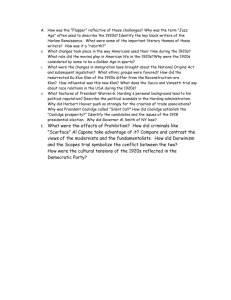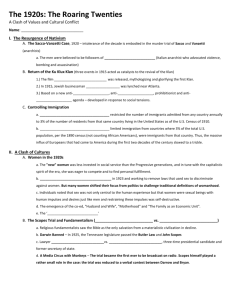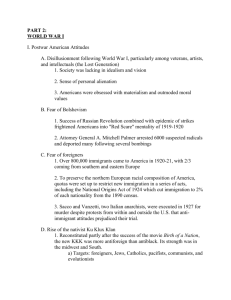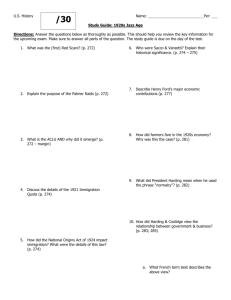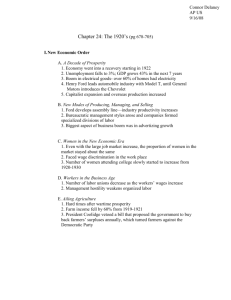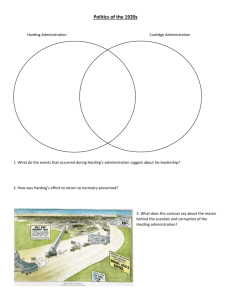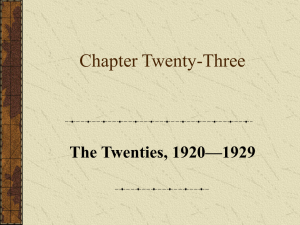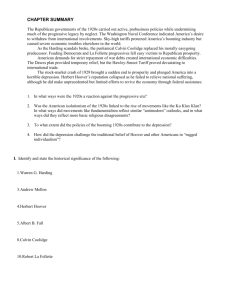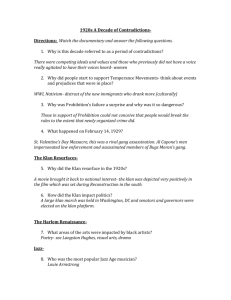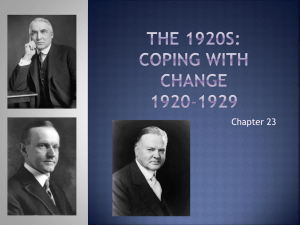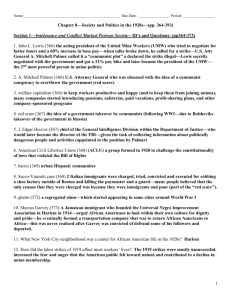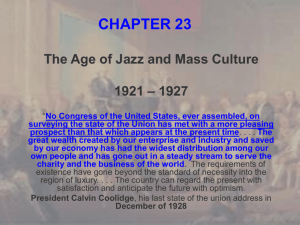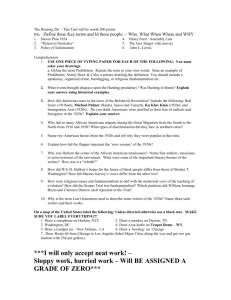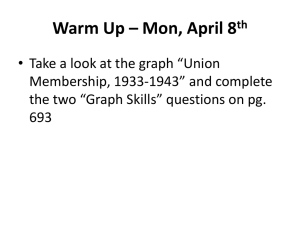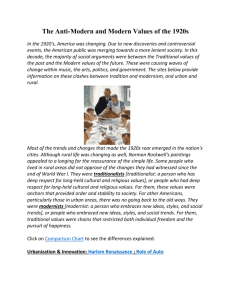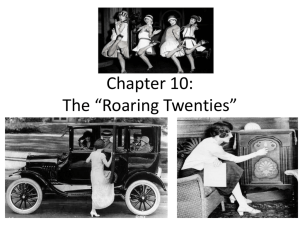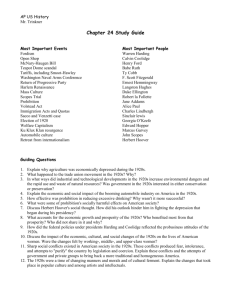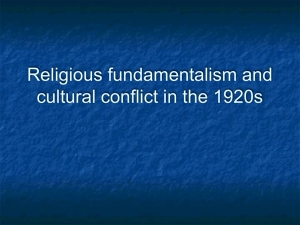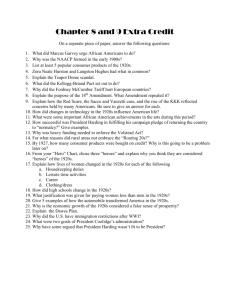APAH Reading Guide Name: Chapter 22 Directions – After reading
advertisement
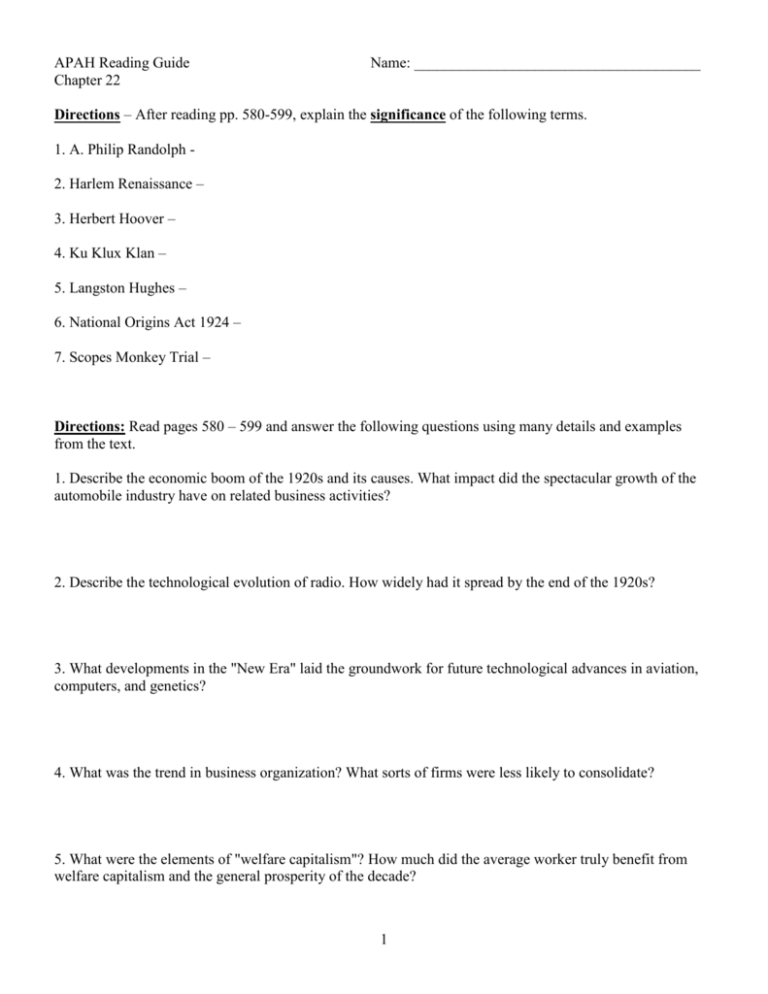
APAH Reading Guide Chapter 22 Name: ______________________________________ Directions – After reading pp. 580-599, explain the significance of the following terms. 1. A. Philip Randolph 2. Harlem Renaissance – 3. Herbert Hoover – 4. Ku Klux Klan – 5. Langston Hughes – 6. National Origins Act 1924 – 7. Scopes Monkey Trial – Directions: Read pages 580 – 599 and answer the following questions using many details and examples from the text. 1. Describe the economic boom of the 1920s and its causes. What impact did the spectacular growth of the automobile industry have on related business activities? 2. Describe the technological evolution of radio. How widely had it spread by the end of the 1920s? 3. What developments in the "New Era" laid the groundwork for future technological advances in aviation, computers, and genetics? 4. What was the trend in business organization? What sorts of firms were less likely to consolidate? 5. What were the elements of "welfare capitalism"? How much did the average worker truly benefit from welfare capitalism and the general prosperity of the decade? 1 6. To what extent was the lag in union membership due to the unions themselves? What were the other causal factors? 7. How did the women and minorities fare with most labor unions? 8. Describe the successes and challenges faced by Asian immigrants. Where were they concentrated? 9. Why was Mexican immigration to the Southwest mostly welcomed despite the discrimination that the migrants faced? 10. Describe the technological and scientific advances in agriculture in the New Era. What effect did these changes have on production and prices? 11. Explain how the concept of "parity" was designed to solve the farm problem. What happened to parity legislation? 12. Describe the new urban consumer society of the 1920s. How did advertising help shape it? 13. How did newspaper chains, mass-circulation magazines, movies, and radio serve as unifying and nationalizing forces in America? 14. How did the image of the "new professional woman" compare with reality for most working women? 2 15. What new attitudes toward motherhood, sex, and leisure developed in the 1920s, especially among middle-class women? 16. What social forces combined to disenchant many intellectuals? What did these people attack? Who were the main attackers? 17. What more basic conflict in society did the controversy over the "noble experiment" of prohibition come to symbolize? What were the results of prohibition? 18. Explain the changes in immigration laws brought about by the National Origins Act and subsequent legislation. What ethnic groups were favored? 19. What helped resurrect the Ku Klux Klan? In addition to African Americans, at whom did the Klan target its rage? How influential was it? 20. Compare and contrast the views of the religious modernists and fundamentalists. How did Darwinism and the Scopes trial symbolize the conflict between the two? How has the conflict persisted? 21. How were the cultural tensions of the 1920s reflected in the Democratic Party? 3 22. What features of President Warren G. Harding's personal background led to his political repudiation? What was the biggest of the various Harding-era scandals? 23. Contrast the personal lives of Harding and Calvin Coolidge. Did their politics and policies differ as much as their personalities? 24. What approach did the Harding and Coolidge administrations take toward taxes and the federal budget? 25. What role did Herbert Hoover play before his presidency? What concept did he champion most vigorously? 26. What were the characteristics of the Republican government during the 1920s? 27. How was the Scopes Monkey Trial and the Sacco and Vanzetti case a reflection of American attitudes during this era? 4 28. Historical Argumentation: Support or refute the following statement using appropriate historical evidence. The automobile is the greatest invention of the 20th century. 29. Historical Argumentation: Support or refute the following statement using appropriate historical evidence. The Immigration Act of 1923 was necessary to the political, social and economic growth of America. 5

